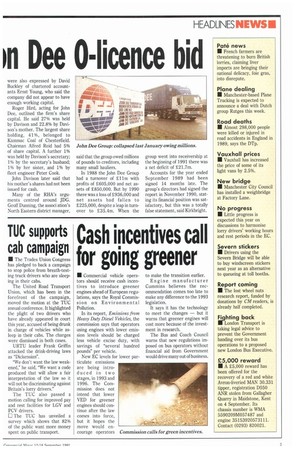Cash deadlim In Dee 0-licence bid
Page 6

Page 7

If you've noticed an error in this article please click here to report it so we can fix it.
• John Davison, former boss of the John Dee Group, has been given a month to inject more cash into the new John Dee — otherwise the company will be closed. JOG crashed in January owing millions of pounds. Davison was applying for a new national licence for 116 vehicles and 250 trailers before North Eastern LA Frederick Whalley; he has also applied for licenses in four other Traffic Areas.
But the Road Haulage Association is fighting all the applications, claiming the newly formed John Dee is already in financial difficulties: it also alleges that the firm lacks good repute. Whalley adjourned the hearing until the end of October, but the company's interim licence was only extended to the end of September. Davison has pledged to inject cash into the company within three weeks.
Stephen Kirkbright, acting for the RHA, told Whalley that figures from John Dee showed the new company is already technically insolvent as its March balance sheet showed an excess of current liabilities over current assets of £367,211. Bank statements revealed a worsening situation and John Dee was running on its creditors' money, he added. The financial mismanagement ofJDG, and during the first three months of trading of the new company, could only be attributed to gross incompetence, gross recklessness, or worse, said Kirkbright.
Grave reservations about John Dee's financial resources were also expressed by David Buckley of chartered accountants Ernst Young, who said the company did not appear to have enough working capital.
Roger Hird, acting for John Dee, outlined the firm's share capital. He said 27% was held by Davison and 22.8% by Davison's mother. The largest share holding, 41%, belonged to Kammac Coal of Chesterfield. Chairman Alfred Reid had 5% of share capital. A further 1% was held by Davison's secretary; 1% by the secretary's husband; 1% by her sister, and 1% by fleet engineer Peter Cook.
John Davison later said that his mother's shares had not been issued for cash.
Many of the RHA's arguments centred around JDG. Geoff Dunning, the associ ation's North Eastern district manager, said that the group owed millions of pounds to creditors, including many small hauliers.
In 1988 the John Dee Group had a turnover of £11m with profits of £605,000 and net assets of £850,000. But by 1990 there was a loss of £936,000 and net assets had fallen to £225,000, despite a leap in turnover to £35.4m. When the group went into receivership at the beginning of 1991 there was a net deficit of £21.7m.
Accounts for the year ended September 1989 had been signed 14 months late. The group's directors had signed the report in November 1990, stating its financial position was satisfactory, but this was a totally false statement, said Kirkbright.
























































































